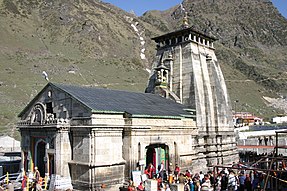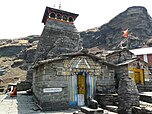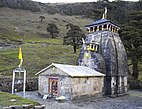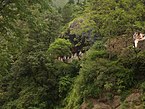
Back પંચકેદાર Gujarati पंच केदार Hindi ಪಂಚ ಕೇದಾರ Kannada പഞ്ച കേദാരം Malayalam Панч-кедар Russian பஞ்ச கேதார தலங்கள் Tamil పంచ్ కేదార్ Tegulu Панч-Кедар Ukrainian
| Panch Kedar, Kedarnath | |
|---|---|
पञ्चकेदार | |
| Religion | |
| Affiliation | Hinduism |
| Deity | Shiva |
| Location | |
| State | Uttarakhand |
| Country | India |
| Geographic coordinates | Kedarnath 30°43′48″N 79°4′12″E / 30.73000°N 79.07000°E, Tungnath 30°29′22″N 79°12′55″E / 30.48944°N 79.21528°E, Rudranath 30°31′10″N 79°19′6″E / 30.51944°N 79.31833°E, Madhyamaheshwar 30°38′13″N 79°12′58″E / 30.63694°N 79.21611°E and Kalpeshwar 30°34′37.35″N 79°25′22.49″E / 30.5770417°N 79.4229139°E |
| Architecture | |
| Type | North Indian architecture |
| Creator | Pandavas (Hindu tradition) |
| Completed | Unknown |
| Part of a series on |
| Shaivism |
|---|
 |
|
|
Panch Kedar (Sanskrit: पञ्चकेदार, romanized: Pañcakedāra), rendered Pancha Kedara in Sanskrit,[1] refers to five Hindu temples or holy places of the Shaivite sect dedicated to god Shiva. They are located in the Garhwal Himalayan region in Uttarakhand, India. They are the subject of many legends that directly link their creation to Pandavas, the heroes of the Indian epic Mahabharata.[2]
The five temples designated in the strict pecking order to be followed for pilgrimage for worship are the Kedarnath Temple (Sanskrit: केदारनाथ) at an altitude of 3,583 m (11,755 ft), the Tungnath Temple (तुङ्गनाथ)(3,680 m or 12,070 ft), the Rudranath Temple (रुद्रनाथ) (3,559 m or 11,677 ft), the Madhyamaheshwar Temple (मध्यमहेश्वर) or Madmaheshwar (3,490 m or 11,450 ft) and the Kalpeshwar Temple (कल्पेश्वर) (2,200 m or 7,200 ft). The Kedarnath is the main temple, which is part of four Chota Char Dhams (literally 'the small four abodes/seats') or pilgrimage centers of the Garhwal Himalayas; the other three dhams are the Badrinath, Yamunotri and Gangotri. Kedarnath is also one of the twelve Jyotirlingas.[3][4]
The Garhwal region is also called the Kedar-Khanda after Kedar — the local name for Shiva. The region abounds in emblems and aniconic forms of Shaiva sect of Shiva, much more than the Vaishnava sect. The western part of this region in particular, which constitutes half of Chamoli district being known as Kedar-Kshetra or Kedar mandala, encompasses in its ambit all the five temples constituting the Panch Kedar.[5]
Visitors to Kedarnath shrine, the first of the Panch Kedar temples for which records are available, was an impressive 557,923 in 2007 as against 87,629 in 1987, a quantum jump in 20 years.[6]
- ^ Jacobsen, Knut A. (5 March 2013). Pilgrimage in the Hindu Tradition: Salvific Space. Routledge. p. 141. ISBN 978-1-136-24031-7.
- ^ "Eight days of bliss". Archived from the original on 15 April 2012. Retrieved 5 July 2009.
{{cite web}}: CS1 maint: unfit URL (link) - ^ Harshwanti Bisht (1994). Tourism in Garhwal Himalaya. Indus Publishing. pp. 84–86. ISBN 9788173870064. Retrieved 5 July 2009.
{{cite book}}:|work=ignored (help) - ^ "Chard Dham Yatra". Government of Uttarakhand, Official website. Archived from the original on 12 May 2009. Retrieved 14 July 2009.
- ^ J. C. Aggarwal; Shanti Swarup Gupta (1995). Uttarakhand: past, present, and future. Concept Publishing Company. p. 222. ISBN 9788170225720.
{{cite book}}:|work=ignored (help) - ^ "Number Of Pilgrims". Archived from the original on 21 July 2011. Retrieved 20 July 2009.
© MMXXIII Rich X Search. We shall prevail. All rights reserved. Rich X Search




